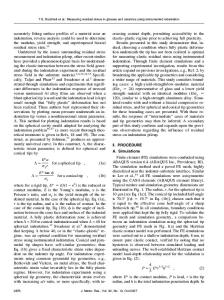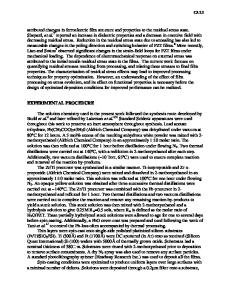Residual stress measurements of thin aluminum metallizations by continuous indentation and x-ray stress measurement tech
- PDF / 577,769 Bytes
- 7 Pages / 576 x 792 pts Page_size
- 51 Downloads / 493 Views
C. A. Paszkiet, M. A. Korhonen, and Che-Yu Li Department of Materials Science and Engineering, Bard Hall, Cornell University, Ithaca, New York 14853 (Received 26 November 1990; accepted 4 June 1991)
Stress relaxation in aluminum films of several thicknesses was characterized by using both continuous indentation and x-ray diffraction techniques. Results of the indentation and x-ray stress measurements compare closely for films of small thicknesses. Indentation data from thicker films do not compare well to the x-ray data due to the presence of a residual stress distribution.
I. INTRODUCTION Aluminum based metallizations, in part because of their low resistivity, comprise the majority of the interconnects used in semiconductor chips. Such metallizations are also characterized by thermal expansion coefficients that are much higher than that of the substrate, typically silicon, on which they are deposited. During processing and use, aluminum based metallizations will, therefore, experience thermal stresses, the magnitude and sign of which depend on their thermal histories. The subsequent relaxation of thermal stresses is often associated with stress-induced void formation and other mechanical damage and is, therefore, an important reliability concern. For this reason, the characterization of stress relaxation in aluminum based metallizations is of both technological and scientific interest. Methods that have been developed for measuring stresses in continuous thin films include beam bending, bulge tests, wafer curvature, and x-ray techniques.1"5 Stress relaxation in aluminum based metallizations has been measured by both wafer curvature and x-ray stress measurement techniques.3"5 Because both wafer curvature and x-ray methods require sample sizes ranging from about 1 cm 2 to an entire wafer, such techniques are limited to large film areas or to large arrays of narrow metallizations. Continuous indentation testing has been used to measure the hardness, elastic modulus, inelastic deformation rate, and adhesion of thin films to substrates.6"10 An advantage of the continuous indentation test is its ability to probe small volumes. Penetration depths as shallow as 50 nm have been achieved, corresponding to plastic deformation volumes under 0.1 /iin 3 . The continuous indentation test measures the resistance of a solid to local deformation. In the case of a thin film bonded to a hard substrate, the measured hardness is sensitive to grain size and orientation, film 2084
J. Mater. Res., Vol. 6, No. 10, Oct 1991
http://journals.cambridge.org
Downloaded: 11 Mar 2015
thickness, level of adhesion of the film to the substrate, and presence of residual stress. Compared to a sample with no residual stress, a thin film under a residual tensile stress will exhibit a lower apparent hardness, because the tensile stress renders the film easier to penetrate. Analogously, a compressive residual stress tends to increase the apparent hardness. For samples that do not undergo large structural changes, changes in hardness with time reflect
Data Loading...









